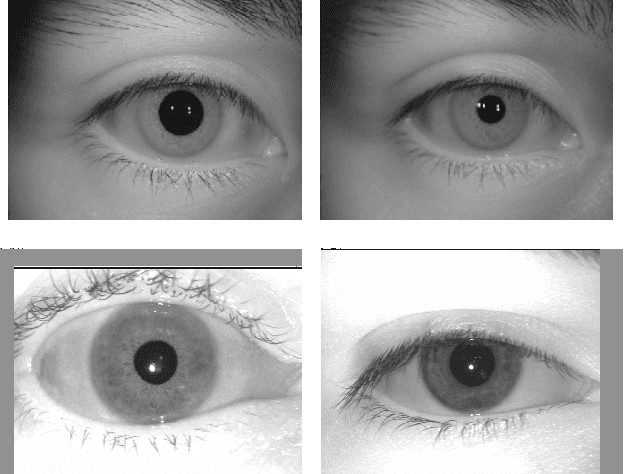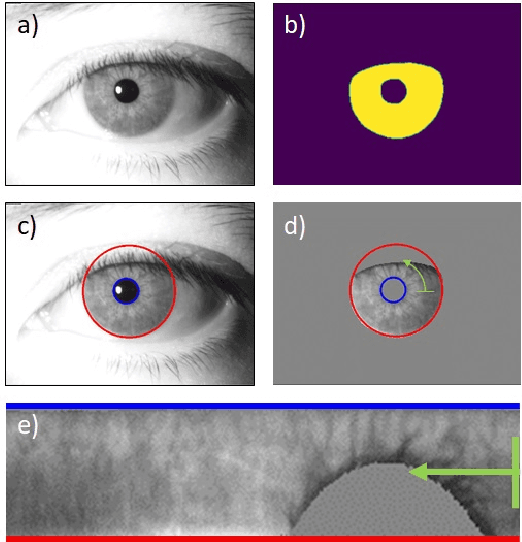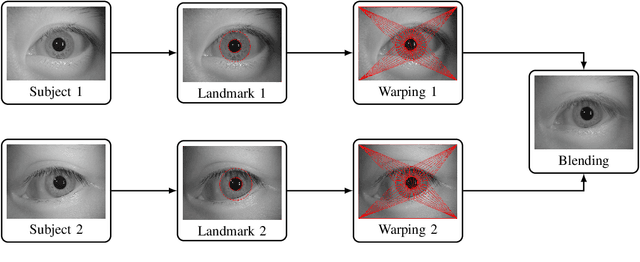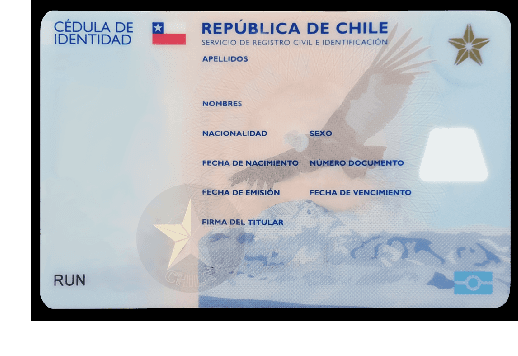Juan E. Tapia
Towards Iris Presentation Attack Detection with Foundation Models
Jan 10, 2025



Abstract:Foundation models are becoming increasingly popular due to their strong generalization capabilities resulting from being trained on huge datasets. These generalization capabilities are attractive in areas such as NIR Iris Presentation Attack Detection (PAD), in which databases are limited in the number of subjects and diversity of attack instruments, and there is no correspondence between the bona fide and attack images because, most of the time, they do not belong to the same subjects. This work explores an iris PAD approach based on two foundation models, DinoV2 and VisualOpenClip. The results show that fine-tuning prediction with a small neural network as head overpasses the state-of-the-art performance based on deep learning approaches. However, systems trained from scratch have still reached better results if bona fide and attack images are available.
Few-Shot Learning: Expanding ID Cards Presentation Attack Detection to Unknown ID Countries
Sep 10, 2024Abstract:This paper proposes a Few-shot Learning (FSL) approach for detecting Presentation Attacks on ID Cards deployed in a remote verification system and its extension to new countries. Our research analyses the performance of Prototypical Networks across documents from Spain and Chile as a baseline and measures the extension of generalisation capabilities of new ID Card countries such as Argentina and Costa Rica. Specifically targeting the challenge of screen display presentation attacks. By leveraging convolutional architectures and meta-learning principles embodied in Prototypical Networks, we have crafted a model that demonstrates high efficacy with Few-shot examples. This research reveals that competitive performance can be achieved with as Few-shots as five unique identities and with under 100 images per new country added. This opens a new insight for novel generalised Presentation Attack Detection on ID cards to unknown attacks.
First Competition on Presentation Attack Detection on ID Card
Aug 31, 2024



Abstract:This paper summarises the Competition on Presentation Attack Detection on ID Cards (PAD-IDCard) held at the 2024 International Joint Conference on Biometrics (IJCB2024). The competition attracted a total of ten registered teams, both from academia and industry. In the end, the participating teams submitted five valid submissions, with eight models to be evaluated by the organisers. The competition presented an independent assessment of current state-of-the-art algorithms. Today, no independent evaluation on cross-dataset is available; therefore, this work determined the state-of-the-art on ID cards. To reach this goal, a sequestered test set and baseline algorithms were used to evaluate and compare all the proposals. The sequestered test dataset contains ID cards from four different countries. In summary, a team that chose to be "Anonymous" reached the best average ranking results of 74.80%, followed very closely by the "IDVC" team with 77.65%.
On the Feasibility of Creating Iris Periocular Morphed Images
Aug 24, 2024



Abstract:In the last few years, face morphing has been shown to be a complex challenge for Face Recognition Systems (FRS). Thus, the evaluation of other biometric modalities such as fingerprint, iris, and others must be explored and evaluated to enhance biometric systems. This work proposes an end-to-end framework to produce iris morphs at the image level, creating morphs from Periocular iris images. This framework considers different stages such as pair subject selection, segmentation, morph creation, and a new iris recognition system. In order to create realistic morphed images, two approaches for subject selection are explored: random selection and similar radius size selection. A vulnerability analysis and a Single Morphing Attack Detection algorithm were also explored. The results show that this approach obtained very realistic images that can confuse conventional iris recognition systems.
Generating Automatically Print/Scan Textures for Morphing Attack Detection Applications
Aug 18, 2024Abstract:Morphing Attack Detection (MAD) is a relevant topic that aims to detect attempts by unauthorised individuals to access a "valid" identity. One of the main scenarios is printing morphed images and submitting the respective print in a passport application process. Today, small datasets are available to train the MAD algorithm because of privacy concerns and the limitations resulting from the effort associated with the printing and scanning of images at large numbers. In order to improve the detection capabilities and spot such morphing attacks, it will be necessary to have a larger and more realistic dataset representing the passport application scenario with the diversity of devices and the resulting printed scanned or compressed images. Creating training data representing the diversity of attacks is a very demanding task because the training material is developed manually. This paper proposes two different methods based on transfer-transfer for automatically creating digital print/scan face images and using such images in the training of a Morphing Attack Detection algorithm. Our proposed method can reach an Equal Error Rate (EER) of 3.84% and 1.92% on the FRGC/FERET database when including our synthetic and texture-transfer print/scan with 600 dpi to handcrafted images, respectively.
Open-Set: ID Card Presentation Attack Detection using Neural Transfer Style
Dec 21, 2023Abstract:The accurate detection of ID card Presentation Attacks (PA) is becoming increasingly important due to the rising number of online/remote services that require the presentation of digital photographs of ID cards for digital onboarding or authentication. Furthermore, cybercriminals are continuously searching for innovative ways to fool authentication systems to gain unauthorized access to these services. Although advances in neural network design and training have pushed image classification to the state of the art, one of the main challenges faced by the development of fraud detection systems is the curation of representative datasets for training and evaluation. The handcrafted creation of representative presentation attack samples often requires expertise and is very time-consuming, thus an automatic process of obtaining high-quality data is highly desirable. This work explores ID card Presentation Attack Instruments (PAI) in order to improve the generation of samples with four Generative Adversarial Networks (GANs) based image translation models and analyses the effectiveness of the generated data for training fraud detection systems. Using open-source data, we show that synthetic attack presentations are an adequate complement for additional real attack presentations, where we obtain an EER performance increase of 0.63% points for print attacks and a loss of 0.29% for screen capture attacks.
Fitness-for-Duty Classification using Temporal Sequences of Iris Periocular images
Apr 24, 2023Abstract:Fitness for Duty (FFD) techniques detects whether a subject is Fit to perform their work safely, which means no reduced alertness condition and security, or if they are Unfit, which means alertness condition reduced by sleepiness or consumption of alcohol and drugs. Human iris behaviour provides valuable information to predict FFD since pupil and iris movements are controlled by the central nervous system and are influenced by illumination, fatigue, alcohol, and drugs. This work aims to classify FFD using sequences of 8 iris images and to extract spatial and temporal information using Convolutional Neural Networks (CNN) and Long Short Term Memory Networks (LSTM). Our results achieved a precision of 81.4\% and 96.9\% for the prediction of Fit and Unfit subjects, respectively. The results also show that it is possible to determine if a subject is under alcohol, drug, and sleepiness conditions. Sleepiness can be identified as the most difficult condition to be determined. This system opens a different insight into iris biometric applications.
Synthetic ID Card Image Generation for Improving Presentation Attack Detection
Oct 31, 2022



Abstract:Currently, it is ever more common to access online services for activities which formerly required physical attendance. From banking operations to visa applications, a significant number of processes have been digitised, especially since the advent of the COVID-19 pandemic, requiring remote biometric authentication of the user. On the downside, some subjects intend to interfere with the normal operation of remote systems for personal profit by using fake identity documents, such as passports and ID cards. Deep learning solutions to detect such frauds have been presented in the literature. However, due to privacy concerns and the sensitive nature of personal identity documents, developing a dataset with the necessary number of examples for training deep neural networks is challenging. This work explores three methods for synthetically generating ID card images to increase the amount of data while training fraud-detection networks. These methods include computer vision algorithms and Generative Adversarial Networks. Our results indicate that databases can be supplemented with synthetic images without any loss in performance for the print/scan Presentation Attack Instrument Species (PAIS) and a loss in performance of 1% for the screen capture PAIS.
Towards an efficient Iris Recognition System on Embedded Devices
Oct 24, 2022Abstract:Iris Recognition (IR) is one of the market's most reliable and accurate biometric systems. Today, it is challenging to build NIR-capturing devices under the premise of hardware price reduction. Commercial NIR sensors are protected from modification. The process of building a new device is not trivial because it is required to start from scratch with the process of capturing images with quality, calibrating operational distances, and building lightweight software such as eyes/iris detectors and segmentation sub-systems. In light of such challenges, this work aims to develop and implement iris recognition software in an embedding system and calibrate NIR in a contactless binocular setup. We evaluate and contrast speed versus performance obtained with two embedded computers and infrared cameras. Further, a lightweight segmenter sub-system called "Unet_xxs" is proposed, which can be used for iris semantic segmentation under restricted memory resources.
Impact of Face Image Quality Estimation on Presentation Attack Detection
Sep 30, 2022



Abstract:Non-referential face image quality assessment methods have gained popularity as a pre-filtering step on face recognition systems. In most of them, the quality score is usually designed with face matching in mind. However, a small amount of work has been done on measuring their impact and usefulness on Presentation Attack Detection (PAD). In this paper, we study the effect of quality assessment methods on filtering bona fide and attack samples, their impact on PAD systems, and how the performance of such systems is improved when training on a filtered (by quality) dataset. On a Vision Transformer PAD algorithm, a reduction of 20% of the training dataset by removing lower quality samples allowed us to improve the BPCER by 3% in a cross-dataset test.
 Add to Chrome
Add to Chrome Add to Firefox
Add to Firefox Add to Edge
Add to Edge